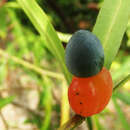ar
الأسماء في صفحات التنقل


Thó͘-sam[1] (ha̍k-miâ: Podocarpus nakaii) sī Tek-peh-kho (Podocarpaceae) ê chhiū-bo̍k, chûn-chāi tī Tâi-oân tiong-lâm-pō͘ soaⁿ-tē.
Thó͘-sam (ha̍k-miâ: Podocarpus nakaii) sī Tek-peh-kho (Podocarpaceae) ê chhiū-bo̍k, chûn-chāi tī Tâi-oân tiong-lâm-pō͘ soaⁿ-tē.
Podocarpus nakaii is a species of conifer in the family Podocarpaceae. It is endemic to Taiwan, scattered in broad-leaf forests in the central part of this island. Ponesterone, which is similar to insect's moulting hormone ecdysone, is obtained from this plant. It was the first ecdysone isolated by Nkanishi et al.[1]
According to the survey results of the sample area, there are about 100 Podocarpus nakaii per hectare. The diameter at breast height of the largest plant is about 30 cm, but nearly 90% of the trees have a diameter at breast height of less than 10 cm; the height of the trees is less than 10 meters. These characteristics show that the Podocarpus nakaii is a shade-tolerant species in the lower layer of the forest. The young seedlings are protected by the big trees and can grow well under the shade of the big trees.[2]
Podocarpus nakaii is a good garden plant because of its beautiful tree shape and lovely bright red receptacles. In addition, according to scholars’ chemical analysis and related activity tests, its bark is considered to have anti-cancer potential.[2]
Podocarpus nakaii is a species of conifer in the family Podocarpaceae. It is endemic to Taiwan, scattered in broad-leaf forests in the central part of this island. Ponesterone, which is similar to insect's moulting hormone ecdysone, is obtained from this plant. It was the first ecdysone isolated by Nkanishi et al.
According to the survey results of the sample area, there are about 100 Podocarpus nakaii per hectare. The diameter at breast height of the largest plant is about 30 cm, but nearly 90% of the trees have a diameter at breast height of less than 10 cm; the height of the trees is less than 10 meters. These characteristics show that the Podocarpus nakaii is a shade-tolerant species in the lower layer of the forest. The young seedlings are protected by the big trees and can grow well under the shade of the big trees.
Podocarpus nakaii is a good garden plant because of its beautiful tree shape and lovely bright red receptacles. In addition, according to scholars’ chemical analysis and related activity tests, its bark is considered to have anti-cancer potential.

The new leaves are red, mature leaves are evergreen all year round.

Peach-shaped receptacle and epimatium

Bark has anticancer potential.

Plant
Podocarpus nakaii é uma espécie de conífera da família Podocarpaceae.
Apenas pode ser encontrada em Taiwan.[1]
Está ameaçada por perda de habitat.
Podocarpus nakaii é uma espécie de conífera da família Podocarpaceae.
Apenas pode ser encontrada em Taiwan.
Está ameaçada por perda de habitat.
Вид названий на честь японського колекціонера рослин Накаї. Росте розкидано в широколистяних (покритонасінних) лісах у центральних горах Тайваню. У цих лісах переважають представники родин Fagaceae і Lauraceae, також помітні Theaceae і Magnoliaceae. Характерні роди дерев є Cyclobalanopsis (= Quercus), Lithocarpus, Machilus (= Persea), Cryptocarya, Schima, Magnolia. Висотний діапазон цього виду становить від 700 до 1800 м над рівнем моря і він існує у помітно мусонному субтропічному кліматі.
Країни поширення: Тайвань.
Середні дерева, до 60 см у діаметрі й 20 м у висоту. Кора сірувато-червоно-коричнева, розшаровуючись на поздовжні тонкі волохаті пластинки. Листки шкірясті, чергові, від ланцетних до лінійно-ланцетних, довжиною 6-8 см, 8-12 мм завширшки, прямі або злегка серповидні, темно-зелені зверху, сріблясто-зелені знизу. Тичинкові стробіли 4-6 см. завдовжки. Насіння одиночне, косояйцеподібне, гостре на верхівці, довжиною 1 см, шириною 8 мм; оболонка м'ясиста, світло-червона у зрілості у квітні, завдовжки 5-12 мм; квітконоси довжиною 2-12 мм. Свіжозрізана заболонь блідо-абрикосово-жовта.
Деревина вирубувалася разом з іншими деревами, і, якщо хорошого розміру і форми використовувалась для конструкцій, столярних виробів, і т.д.
Вид сильно постраждав від загального збезлісення у період після Другої світової війни. Є також останні доповіді видалення зрілих дерев для садівництва.
Podocarpus nakaii là một loài thực vật hạt trần trong họ Thông tre. Loài này được Hayata miêu tả khoa học đầu tiên năm 1916.[1]
Podocarpus nakaii là một loài thực vật hạt trần trong họ Thông tre. Loài này được Hayata miêu tả khoa học đầu tiên năm 1916.
台湾罗汉松(学名:Podocarpus nakaii)又稱為山相思樹、埔里百日青、土杉。为罗汉松科罗汉松属的常綠喬木,为台灣的特有種。
因生育地遭破壞及族群遭挖採,數量持續下降,生存備受威脅。經評估列屬「瀕臨絕滅」級稀有植物。[1]
桃實百日青為台灣特有種,僅分布於台灣中部海拔 1,000 公尺以下之闊葉森林中,在北山坑、蓮華池及日月潭等地皆有發現紀錄。
|access-date=中的日期值 (帮助) |access-date=中的日期值 (帮助)
|access-date=中的日期值 (帮助)